Moray Eel
Muraenidae
Sometimes, groupers invite moray eels to help them hunt!
Advertisement
Moray Eel Scientific Classification
- Kingdom
- Animalia
- Phylum
- Chordata
- Class
- Actinopterygii
- Order
- Anguilliformes
- Family
- Muraenidae
- Scientific Name
- Muraenidae
Read our Complete Guide to Classification of Animals.
Moray Eel Conservation Status
Moray Eel Facts
- Main Prey
- Fish, Squid, Crustaceans
- Name Of Young
- Elver
- Group Behavior
- Solitary
- Fun Fact
- Sometimes, groupers invite moray eels to help them hunt!
- Estimated Population Size
- Unknown
- Most Distinctive Feature
- Two sets of jaws -- one at the front of their mouths and one (pharyngeal) in their throats
- Distinctive Feature
- A long dorsal fin that can run the length of their back
- Optimum pH Level
- 5-7
- Habitat
- Coastal and deep waters
- Diet
- Carnivore
- Favorite Food
- Fish
- Common Name
- Moray Eel
- Group
- Fish
View all of the Moray Eel images!
There are more kinds than you think!
When most people think of a moray eel they think of a huge, secretive eel with tiny, cold eyes and jaws full of impressive fangs. But did you know there are over 200 species of these eels, and they live from the depths of the ocean to freshwater rivers? Read on to learn more about these spectacular creatures.
4 Incredible Facts!
- Groupers sometimes invite moray eels to help them hunt.
- Most of these fish live in saltwater, though Gymnothorax polyuranodon, the many-toothed moray, lives in freshwater, including rivers and estuaries.
- These fish have small gills, so they need to open their mouths to pump oxygenated water through them. This is why so many moray eels are seen with their mouths open. The open mouth is not a sign that the fish is getting ready to attack.
- The moray eel has two sets of jaws. The first is in its mouth, but the second is in its throat.
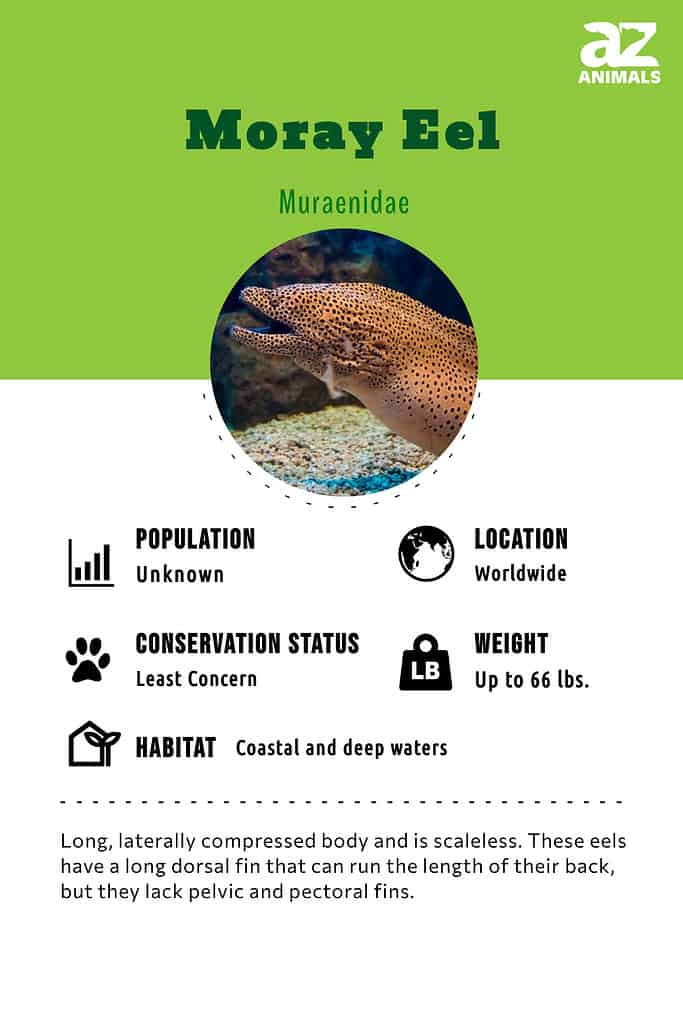
©
Classification and Scientific Name
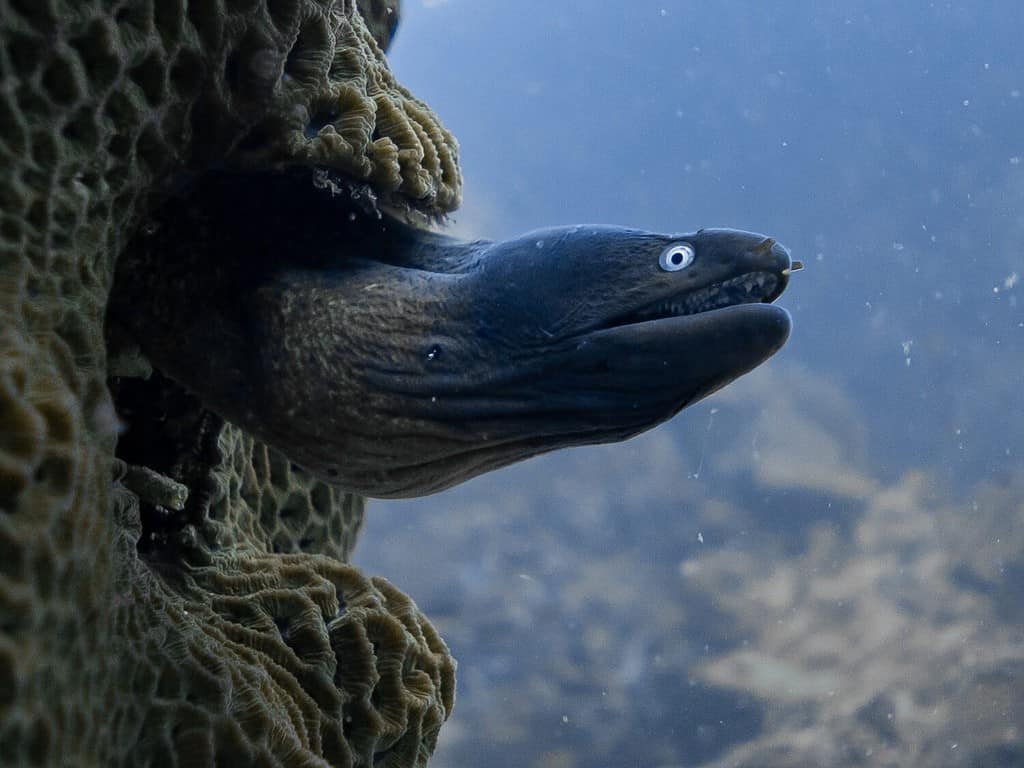
There are over 200 species of moray eels.
©Didier Barriere Doleac/Shutterstock.com
Moray eels belong to the Muraenidae family. The name comes from mūrēna, which is Latin for the Mediterranean moray eel. This word in turn comes from the Greek word muraina. There are 16 genera and over 200 species.
Appearance
The look of the moray has a long, laterally compressed body and is scaleless. These eels have a long dorsal fin that can run the length of their back, but they lack pelvic and pectoral fins. They have long snouts with tiny nostrils, and the type of teeth in the jaws depends on the diet. Some of these fish have two rows of teeth in their top jaw. The California moray has teeth in the roof of its mouth that can fold back to give it a firm bite as it holds its prey. Some morays have teeth that are pointed and curved while others have teeth that resemble human molars. These teeth evolved in morays that need to crush the shells of crustaceans. All moray eels have pharyngeal jaws that shoot into the mouth, rather Xenomorph-like, to help hold on to prey.
Besides this, moray eels come in many sizes, from the diminutive, 4.5-inch long Snyder’s moray eel to the 13-foot slender giant moray eel. The eels also come in a variety of colors and patterns, but they lack scales and protect their skin from toxic mucus. Their eyes are small and don’t see well but depend largely on their sense of smell. This is fine as most moray eels are nocturnal.
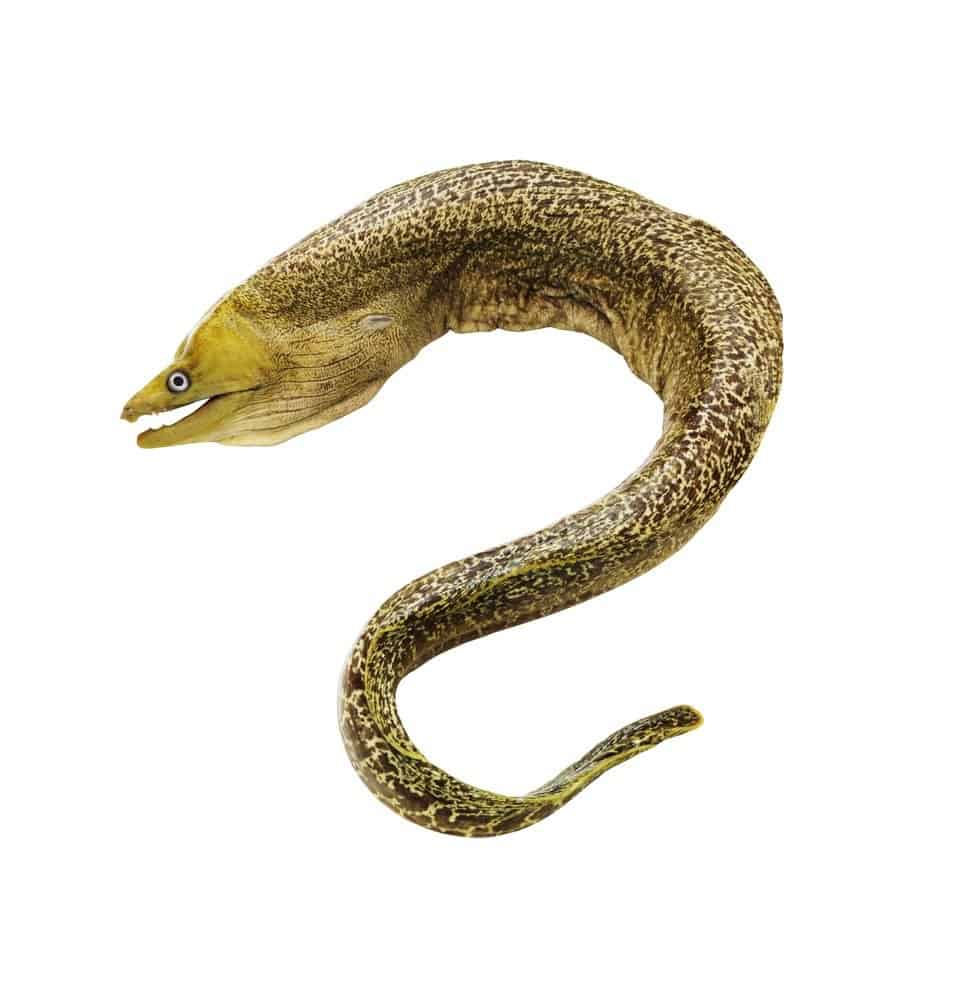
Moray Eels have a long dorsal fin that can run the length of their back, but they lack pelvic and pectoral fins.
©Valerii Evlakhov/Shutterstock.com
Types of Moray Eels
There are over 200 different types of Moray Eels in the world. These are just a few of them!
Giant Eel
Also called the red moray, the giant moray eel, Gymnothorax javanicus isn’t the longest of the morays, for that title belongs to the slender giant moray. However, it is the heaviest. A large animal can weigh as much as 66 pounds and grow to nearly 10 feet in length. Its body is usually brown but red individuals have been seen, and adults have black spots in the area behind their head. It is found in the Indo-Pacific area and can range from Hawaii to southern Japan. It is found in coral reefs and lagoons and spends most of its days hidden in crevices up to 164 feet deep.
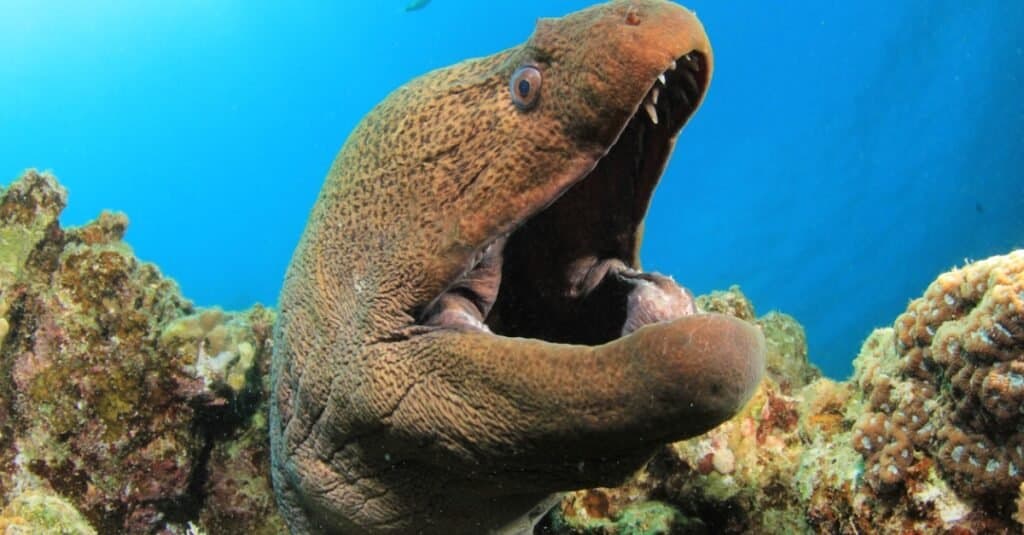
The Giant Moray Eel is the heaviest of these eels.
©Rich Carey/Shutterstock.com
Green Moray Eel
The green moray eel, Gymnothorax funebris isn’t actually green. Its skin is either dark brown or gray, but the mucus secreted by the skin is yellow, which gives the eel a green color. A large green moray can be over 8 feet long and weigh nearly 64 pounds, but most of them are around 6 feet and weigh about 30 pounds. In contrast to the giant moray, the green moray is found in the western part of the Atlantic Ocean and the Caribbean and can be found from New Jersey south to Brazil. This eel lives in coral reefs, harbors, mangroves, and other inter-tidal areas.
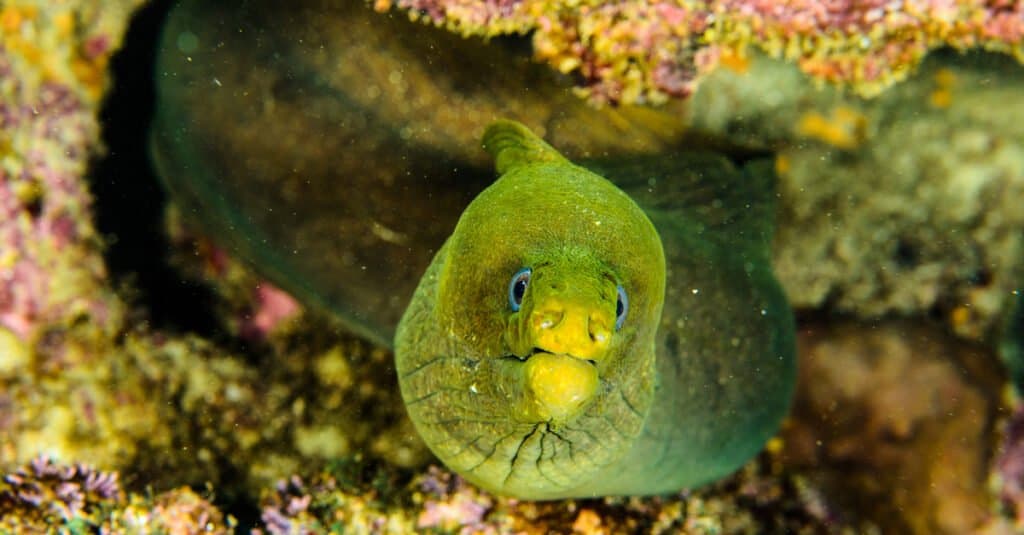
Green moray eels are actually dark brown or gray but look green because they secrete yellow mucus.
©Leonardo Gonzalez/Shutterstock.com
Here are a few more of them:
- Muraena – The Muraena Eel is a large version of the Moray Eel with 12 species. They can be found around coral reefs in the Mediterranean Sea. They are known for their bright colors.
- Dragon Moray Eel – Dragon Moray Eel, also known as the Leopard Moray Eel, can be found through a large stretch of the Indo-Pacific Ocean. Living up to its different names, this eel has striking, bright stripes on its head.
- Yellow-edged Moray Eel – Yellow-edged Moray Eels live in a similar area of the ocean as their dragon cousins, except they typically live at deeper depths. Not as colorful as some other morays, these eels have a dull yellow coloration.
Distribution, Population, and Habitat
These fish are found in warmer waters all over the world. They thrive in both shallow waters and relatively deeper, benthic areas of the oceans. Though scientists don’t know their exact numbers, moray eels are especially numerous in habitats that offer them cover, such as those with rock formations or crevices.
The actual population of moray eels is unknown, but scientists do know that of the millions of eggs released during the spawning period, few hatch, and even fewer larvae reach maturity. As of 2022, the conservation status of most moray eels is least concern.
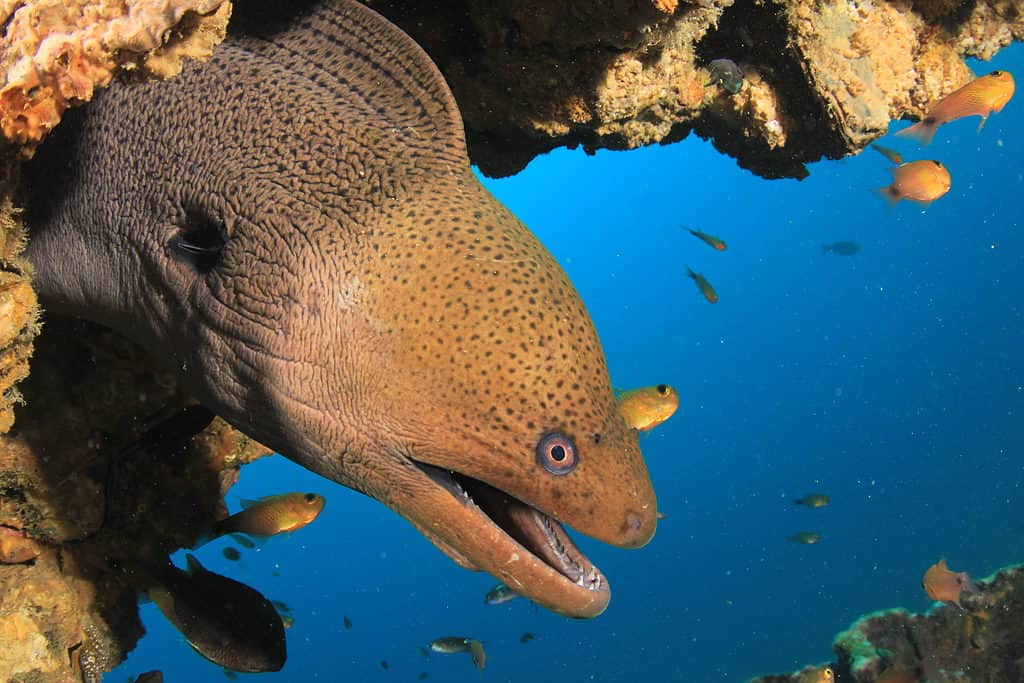
©Rich Carey/Shutterstock.com
Predators and Prey
The largest of the moray eels are most likely the apex predators in their areas, but moray eels are prey for fish such as barracudas and sharks. Humans also kill moray eels, as do sea snakes. These fish prey upon smaller fish, crustaceans, and octopuses. They’ll attack and eat any sort of animal that they can either gulp down or tear into manageable bits.
Reproduction and Lifespan
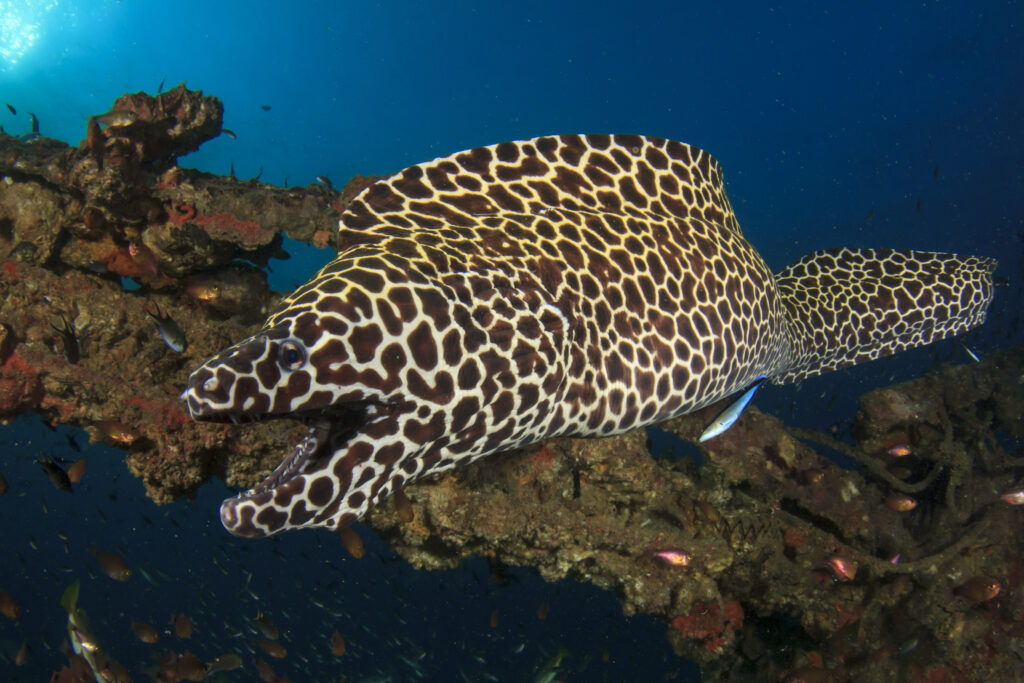
Moray Eel eggs hatch after 5 or 6 weeks.
©Rich Carey/Shutterstock.com
When it comes to reproduction, most moray eels don’t seem to have a breeding season but breed when the circumstances, such as abundant food, are right. Some moray eels migrate a small distance to a spawning site. Once there, the female releases as many as 10,000 eggs with a chemical that attracts males to the area so they can fertilize them. After this, the eels return to their usual home range and take no more care of their offspring.
The eggs hatch after about five or six weeks into pre-larvae which subsist on the tiny animals found in the zooplankton. Depending on the species, they can spend two years drifting on the currents until they’re mature enough to hunt and find shelter.
History and Evolution
There are several interesting evolutions of the Moray Eel that make them one of the more interesting swimmers in our oceans. Their high number of vertebrae makes their bodies long and slender, and they are able to propel themselves through the water quickly. As mentioned their two sets of jaws are an incredible adaptation that has helped different species with differing diets. Some species have smoother teeth to help breakdown prey with shells, and some Moray Eels are able to lay their back jaw’s teeth almost flat to help their food slide through their throats.
Fishing and Cooking
Though some people eat moray eel, this is inadvisable as the eel often is ciguatoxic. Eating a contaminated eel can cause ciguatera fish poisoning, a potentially serious disease.
View all 164 animals that start with MMoray Eel FAQs (Frequently Asked Questions)
Do moray eels eat humans?
Moray eels are not known to eat humans, but the bite of a large eel is powerful and can inflict a grievous wound.
Is the moray eel poisonous?
Moray eels have poison in the slime that covers their skin, and they often have very high levels of ciguatoxin. This makes them dangerous to eat.
Can a moray eel shock you?
Unlike electric eels, moray eels do not shock you. You still wouldn’t want one of the larger ones to attack and bite you.
Is a moray eel electric?
Moray eels are not electric.
How big is a giant moray eel?
Sharks do eat moray eels, and a large shark is one of the few animals that can tackle a large moray eel.
Thank you for reading! Have some feedback for us? Contact the AZ Animals editorial team.
Sources
- Fish Base, Available here: https://www.fishbase.se/Summary/SpeciesSummary.php?ID=1099&AT=moray+eel
- Wikipedia, Available here: https://en.wikipedia.org/wiki/Moray_eel
- Guinness World Records, Available here: https://www.guinnessworldrecords.com/world-records/446191-smallest-eel
- Ocean Today NOAA, Available here: https://oceantoday.noaa.gov/weirdanimals_giantmorayeel/
- Aqua, Available here: https://aqua.org/explore/animals/green-moray-eel
- UniGuide, Available here: https://www.uniguide.com/moray-eel-facts/

















